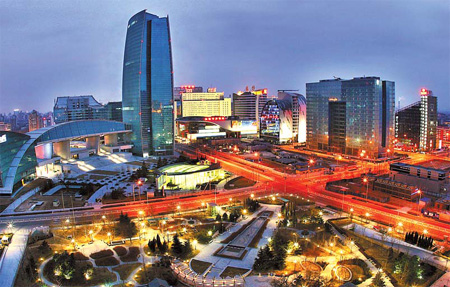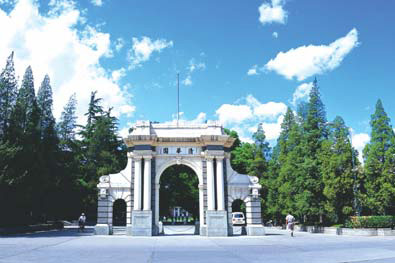HSP: Evolving to urban innovation center Editor's note:
|
A night view of Zhongguancun Square. Photos Provided to China Daily |
|
Prestigious Tsinghua University is one of the 78 higher learning institutes in Haidian district. |
Encouraged by reform policies of the early 1980s, scientists and researchers from Beijing's Haidian district began to quit their jobs. Leaving behind strict management systems, they started their own business on Zhongguancun electronics street. The area later became known as the Zhongguancun science zone, encompassing Haidian Science Park (HSP). Now park officials, experts and entrepreneurs are attending the ongoing Davos forum. Their opinions and experiences are shared on this special report from Sept 13 to 15.
By Yang Cheng
After more than two decades of groundbreaking development, the Haidian Science Park (HSP) at the core of Zhongguancun Science Park is again evolving as it becomes an international urban center for innovation and an innovation downtown for Haidian district.
Covering 217 sq km - nearly half of Haidian district in the northwest of Beijing - the famed HSP is now laying plans to attract more world-level enterprises and offer fertile ground for top-quality personnel to transform from an innovation park into an urban area dedicated to knowledge, invention and new ideas.
"With the thriving development of global scientific innovation, fostering innovative urban centers is a widely recognized national development strategy throughout the world," said Zhao Fengtong, Party secretary of the Zhongguancun Science Park.
The latest goals for the HSP are to be another chapter in its history of groundbreaking developments at Zhongguancun.
In 1987, a story on "Electronic Street" in Zhongguancun published in the People's Daily first pushed the district into the limelight. The story described development of the area and for the first time recognized its innovation and development potential. The park was then approved as the first national high-tech zone in 1988.
In 2009, the HSP was defined as the core area of Zhongguancun National Innovation Model Park, an indication that planners want the HSP to lead the nation into a new era for China's high-tech parks.
The HSP has twice been selected as the experimental and pivotal area for the nation's development of innovation.
"Currently, it is a savvy strategy that the leading park positions itself as an urban innovation center," said Luis Sanz, director general of the International Association of Science Parks, at the first International Symposium on Regional Innovation for Downtown (Haidian) of the Zhongguancun National Innovation Model Park in May this year.
Echoing Sanz, Zhao, who used to serve as the first deputy director of HSP in the late 1980s, noted that developing such an urban center is a strategic step in the Chinese government's efforts to build an innovation-focused country "and sets a new target for the core area of Zhongguancun Science Park".
A high-level meeting scheduled this month will discuss the latest plans and efforts to foster more innovation-focused enterprises with international influence.
The vision calls for HSP to become a concentrated center of state-of-the-art technology and standards with independent intellectual property rights.
Advantages
The top advantage for the area to achieve its goals is unique and vigorous policy support and opportunities forthcoming spurred by its leading innovation capacity.
The area also has a naturally endowed environment of innovation with the largest number of prestigious universities and academies in the nation centered in Haidian, home to half of Beijing's university students.
The district has 251 central and city-level research institutes and 36 percent of all academics in the Academy of Science and Academy of Engineering Science. Together they comprise about 60 percent of the total academics living and working in Beijing.
In another development, some enterprises have forayed onto the international scene to merge with or acquire overseas firms including PC maker Lenovo and Beijing Oriental Electronics Technology Group.
The area's private companies - including management software maker UFIDA and Redflag, developer of a Chinese-language office software - have teamed with leading multinationals to establish research and development centers.
The Dawning 5000A computer born in the HSP ranks second in the top 500 high-performance computers in the world.
A total of 124 companies based in the science park have gone on to overseas listings, including Baidu, Vimicro and OriginSeed, helping the area earn the name "China's Silicon Valley".
Private enterprises in HSP have long been at the frontier of international advanced technologies and have widely joined the business and research operations of leading transnational companies.
The cutting edge high-tech environment is enriched by the area's history and scenery, including ancient imperial resorts such as Xiangshan Park, the Summer Palace, Yuanmingyuan Park and Crouching Buddha Temple.
Efforts
To fulfill the dream of building a technology innovation center with international influence and rise even higher as a site for global research and development, the latest blueprint calls for the northern part of HSP to become home to new industries in software, information technology, new materials, new energy, environmental protection and pharmaceutical engineering.
Planning and construction of auxiliary facilities including transportation, administrative services and residential complexes are now underway.
Plans also include better quality services and amenities along with continued emphasis on education, which together are expected to injecting new vigor in higher learning and research.
The area's industrial output is projected to surpass 10 trillion yuan and be a major driver of economic growth in Beijing.
Well-developed services for finance, science, information and equity exchange are also expected to help the area meet a projected industrial output of 10 trillion yuan.
Plans also call for popular tourism resorts in the northwest of Beijing to be improved and further integrated. In addition to ancient royal family resorts, Dajue Temple, Jiufeng Peak, Fenghuangling Mountain and Yangtai Mountain will be included in an overall tourism development blueprint.
In the south of the HSP, a range of high-end commercial services will be fomented and areas developed for the creative industry.
As a result, exhibitions, conventions, arts, sports and entertainment facilities are expected to cater to the rising demand from modern enterprises and local citizens.
"The answer to the question of how to become internationalized can only be found in a real international environment," Zhao said.
Statistics show that during the first half of this year, the GDP in Haidian district hit up 14 percent year-on-year.
(China Daily 09/13/2010)
















